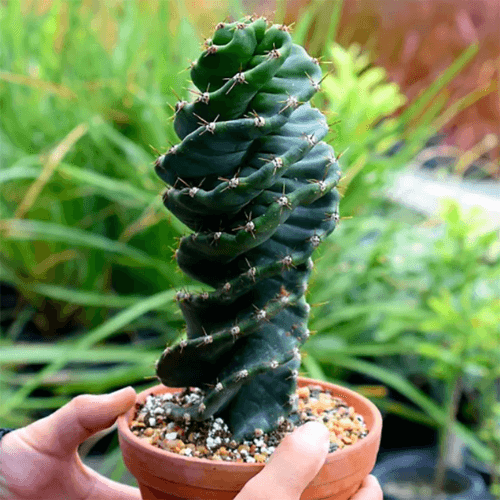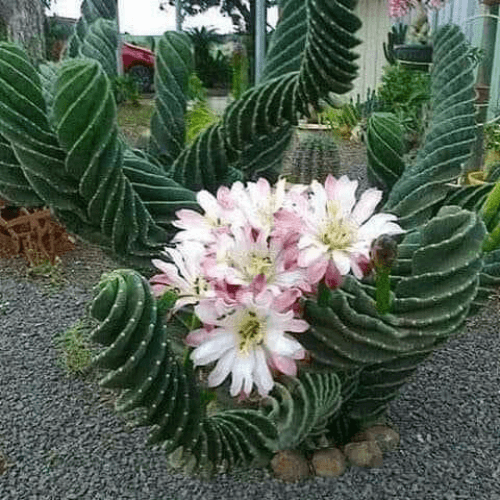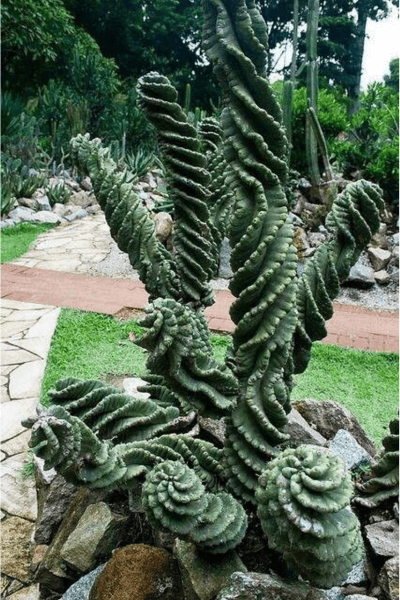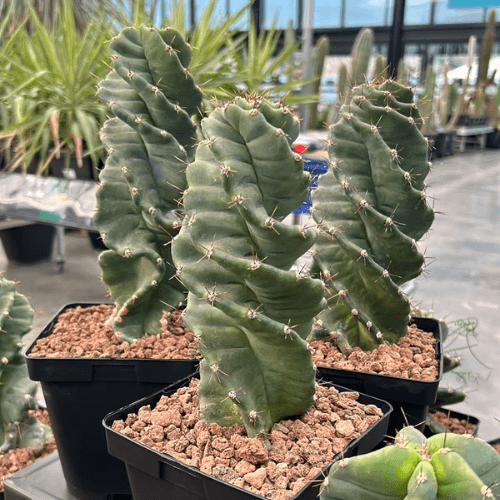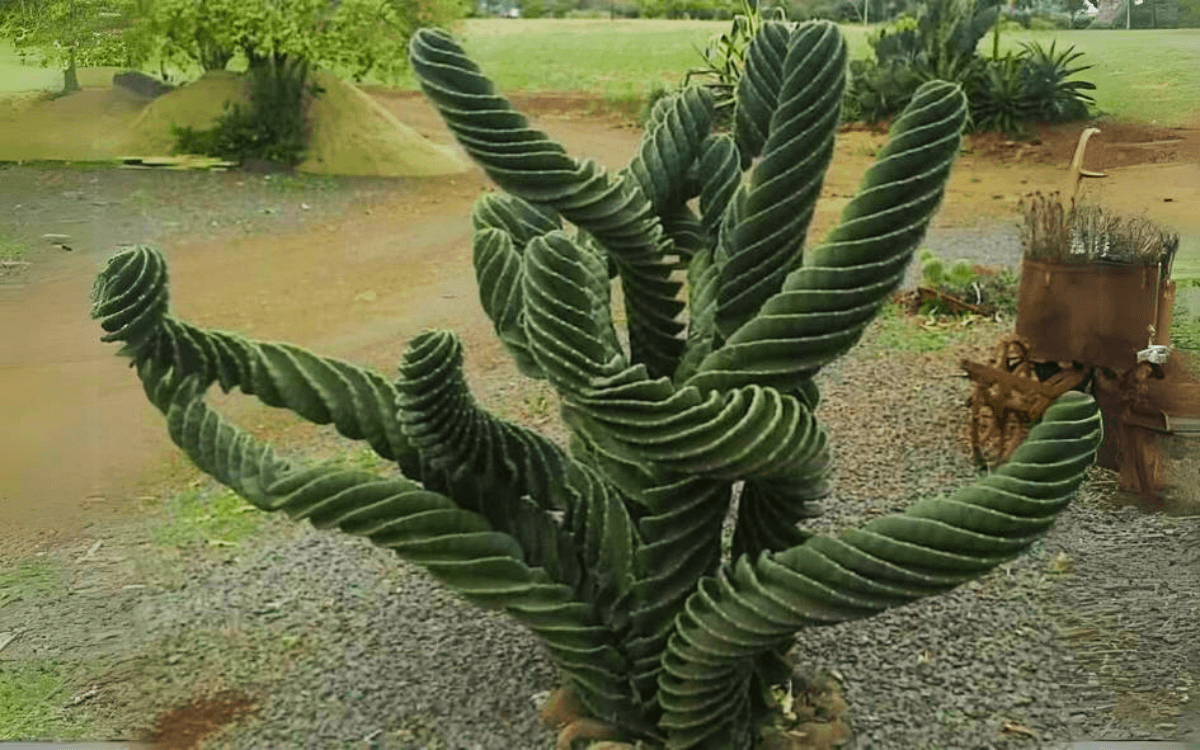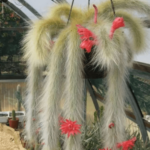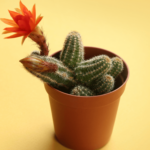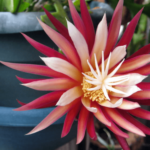The spiral cactus, scientifically known as Cereus peruvianus ‘spiralis’, features a spiral growth that sets it apart from other plants.
Continue reading, because in this article you will see several pictures of this plant, curiosities, and essential tips for its cultivation.
Characteristics and Curiosities of the Plant
The spiral cactus is native to Peru, which explains its adaptation to hot and dry climates. Its main characteristic, the spiral shape is a natural adaptation that allows the cactus to evenly capture direct sunlight throughout its stem.
This plant can reach up to 4 meters (about 13 feet) in height and have up to 12 centimeters (about 4.7 inches) in diameter, but its size and appearance may vary depending on cultivation conditions.
Like the peanut cactus, this is not a toxic plant, but it is recommended that it be kept in high or inaccessible places to avoid accidents due to its thorns.
When well cultivated, this cactus produces fruits the size of an apple, in the photo below you can see the appearance of these fruits.

See now the care necessary to take care of this plant.
Ideal Temperature for Cultivation
The spiral cactus should be cultivated in warm climates, where daytime temperatures range from 20°C to 30°C (68°F to 86°F).
The plant is remarkably resistant to high temperatures, being able to withstand even those that exceed this range, which makes it an excellent choice for hotter regions or for places that experience intense summers.
However, it is important to protect it from the cold, especially from frost.
Exposure to very low temperatures can be harmful to the plant, so in regions where cold weather is a concern, it is advisable to keep the cactus indoors during the colder months or in greenhouses where the temperature can be controlled.
Humidity and Lighting
This cactus prefers environments with medium to low humidity, aligning well with most typical cactus environments.
Excessively humid environments may not be ideal, as they can contribute to health problems for the plant, such as root rot.
Regarding lighting, the spiral cactus requires a significant amount of sunlight to thrive.
The plant should receive more than 4 hours of direct sunlight daily, which is vital for its development and overall health.
A well-ventilated area, which avoids strong drafts but still offers adequate airflow, is ideal to keep the spiral cactus in its best state.
Learn more:
- Fishbone Cactus (Selenicereus anthonyanus) – Care Guide
- Monkey Tail Cactus: How to Care and Propagate
- How to Care for Cactus and Mini Cactus (7 Simple Steps)
How to Water
The spiral cactus is adapted to store water in its tissues, allowing it to survive with relatively low amounts of water.
Therefore, you should be careful not to overwater this cactus.
Before watering the spiral cactus, it is essential to check the moisture of the substrate in the pot. The ideal method is to insert a finger or a stick into the soil to assess the moisture.
The plant should be watered only when the top layer of the substrate is completely dry. If the soil is still moist to the touch, it is advisable to delay watering for a few more days to avoid excessive moisture.
Additionally, it is crucial to ensure that the soil has good drainage to prevent water from accumulating around the roots, which could cause rot. Using a pot with drainage holes and well-drained soil is vital for the health of the cactus.
Ideal Soil and How to Fertilize
This cactus needs a soil with good drainage to prevent excessive water retention, which can lead to root rot, a fatal condition for many succulents.
The ideal soil mix for the spiral cactus should include half sand and half vegetable soil. This combination ensures that the soil is light and porous, facilitating air flow and water drainage.
Adding a small amount of organic matter to the soil can enrich the available nutrients, without compromising the drainage.
When it comes to fertilizing, bokashi is highly recommended due to its rich composition of essential nutrients.
Bokashi can be applied to the soil once a month to promote robust development and support the plant’s flowering. However, it is vital to avoid fertilizing during the winter, a period when the cactus enters a state of dormancy and growth is minimized.
Moreover, it is important to be cautious with the amount of fertilizer used. Too much fertilizer can be as harmful as too little, leading to problems such as root burn and other stresses that can negatively affect the health of the cactus.
Always follow the manufacturer’s instructions for the fertilizer to ensure proper dosage and avoid nutrient overfeeding.
Repotting
Repotting is an important step in caring for the spiral cactus, usually necessary when the plant grows beyond the available space in the current pot or when the substrate becomes very old.
The ideal time to repot is during the spring or summer, when the plant is most active. Avoid repotting during the winter or periods of cold weather.
For repotting:
- Carefully remove the cactus from the old pot, avoiding damaging the roots.
- Prepare the new pot (opt for a pot that has holes to ensure good drainage).
- With the appropriate substrate and position the plant carefully, ensuring that it is stable and centered.
Propagation
Propagation of the spiral cactus can be done in several ways, the simplest and most effective being through its offshoots.
After flowering, allow the flower to dry completely, and then cut the stem on which it was supported.
Plant this stem in a light substrate, under the same conditions recommended for the adult cactus, and keep the soil slightly moist until the offshoot takes root.
Alternatively, propagation can also be done through seeds. Plant the seeds in a light and moist soil and wait for germination.
Pests, Diseases and Other Problems
Below are the main problems that may appear on your spiral cactus.
Powdery Mildew: This fungal disease is identifiable by white, tangled spots that appear on parts of the plant. To treat powdery mildew, it is necessary to remove the affected areas carefully and apply a copper-based fungicide, which helps control the spread of the fungus.
Fungal Diseases (for example, root or fruit rot): these problems attack the plant’s structure, potentially causing significant damage. The treatment involves the application of specific fungicides, suitable for each type of disease. It is crucial to act quickly to prevent irreversible damage to the plant.
Red Spider Mite: This pest is a small insect that feeds on the plant’s sap, resulting in a dry and brown appearance of the affected areas. To combat the red spider mite, remove the affected parts of the plant and apply an effective acaricide to eliminate these insects and protect the plant.
To avoid these problems, offer good cultivation, constantly monitor your cacti, and keep them in open, clean, and ventilated locations.

